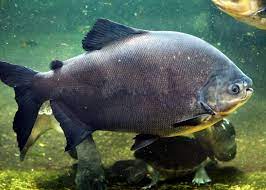The Pacu fish, scientifically known as Piaractus brachypomus, is a remarkable and intriguing species that has captured the attention of fish enthusiasts and researchers alike. Native to the Amazon and Orinoco river basins in South America, this freshwater fish is closely related to the well-known piranha but exhibits unique characteristics that set it apart. In this blog, we will delve into the fascinating world of the Pacu fish, exploring its physical traits, natural habitat, behavior, and conservation status.
I. Physical Traits: Pacu fish are relatively large, with adults reaching sizes of up to three feet in length and weighing over 50 pounds. They are characterized by their laterally compressed bodies and deeply forked tails. One of the most distinctive features of the Pacu fish is its human-like teeth, which are surprisingly strong and resemble molars. These teeth are adapted for grinding and crushing the plant material that makes up a significant portion of their diet.
II. Habitat and Distribution: Pacu fish are native to the freshwater rivers and lakes of the Amazon and Orinoco river basins in South America. They prefer slow-moving and calm waters with plenty of vegetation, as these areas provide an abundant supply of fruits, nuts, and other plant material that form an essential part of their diet. In recent years, Pacu fish have been introduced to various regions outside their native range, often unintentionally through the aquarium trade or aquaculture practices.
III. Feeding Habits: While Pacu fish are primarily omnivorous, their diet is predominantly herbivorous. They are known as “fruit-eating fish” due to their fondness for consuming fallen fruits, seeds, and nuts that drop into the water from overhanging trees. This behavior not only makes them important agents for seed dispersal in their natural habitat but also contributes to their role in shaping the ecosystem.
IV. Reproduction and Life Cycle: The breeding habits of Pacu fish are fascinating. During the spawning season, adult Pacus gather in shallow areas to lay their eggs. After hatching, the fry are guarded and protected by their parents until they are old enough to fend for themselves. With proper care and ample food resources, Pacu fish can live up to 25 years in captivity.
V. Relationship with Humans: Pacu fish have garnered considerable attention due to their resemblance to piranhas and their reputation for biting human extremities. However, these incidents are relatively rare and are mostly a result of misunderstanding and misidentification. In their natural environment, Pacu fish play a vital role in the ecosystem by contributing to nutrient cycling and seed dispersal.
VI. Conservation Status: While Pacu fish are not currently listed as endangered, they do face threats in their native habitats. Habitat destruction, overfishing, and pollution are significant challenges that affect the overall health of their populations. Additionally, the introduction of Pacu fish to non-native waters can have detrimental effects on local ecosystems and native species.
VII. Importance in Aquaculture: Pacu fish are of considerable economic value in aquaculture, especially in South America and parts of Asia. They are cultivated for their meat, which is considered a delicacy in some regions. However, responsible aquaculture practices are essential to ensure the sustainable management of these fish and avoid potential negative impacts on the environment.
VIII. Misconceptions and Challenges: Despite their friendly nature and overall significance in the ecosystem, Pacu fish have often been misrepresented and misunderstood in popular culture. Raising awareness about their biology, behavior, and ecological role is crucial for dispelling myths and promoting a more accurate understanding of these fascinating creatures.
Conclusion: The Pacu fish is a captivating species that adds diversity and intrigue to the aquatic ecosystems of South America. With its unique physical traits, herbivorous diet, and role in seed dispersal, this fish has much to offer in terms of ecological importance. As we continue to explore and appreciate the wonders of the natural world, let us also strive to protect and conserve the habitats that support species like the Pacu fish for generations to come.




















Add Comment